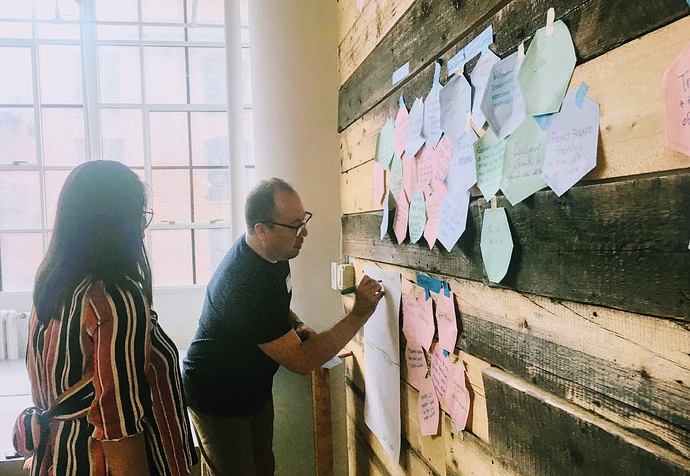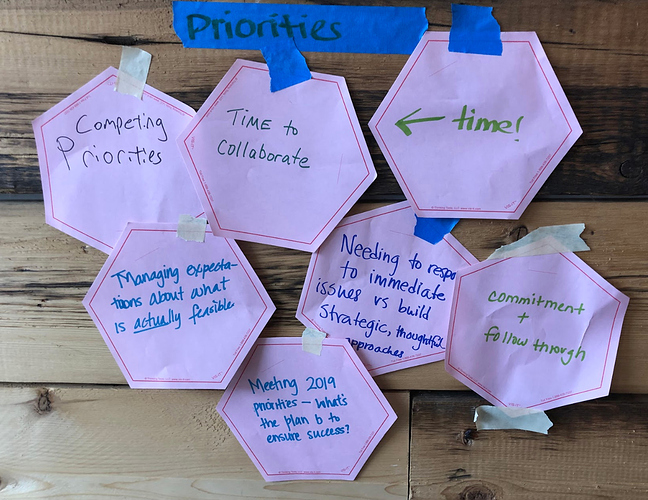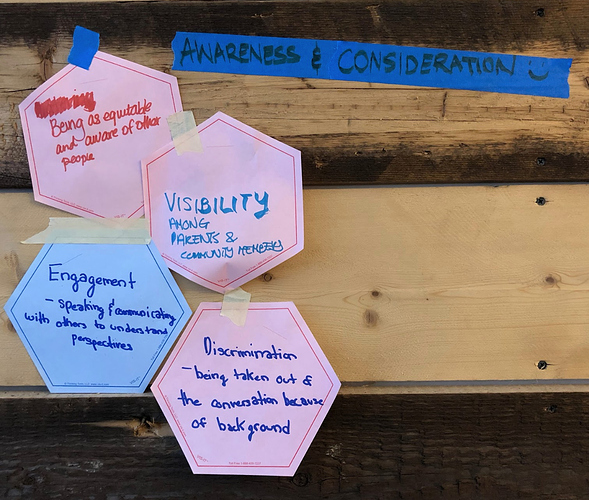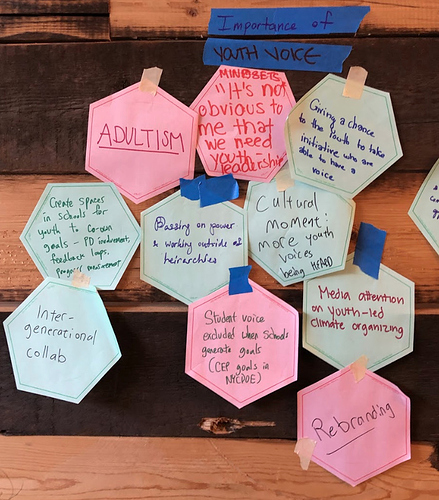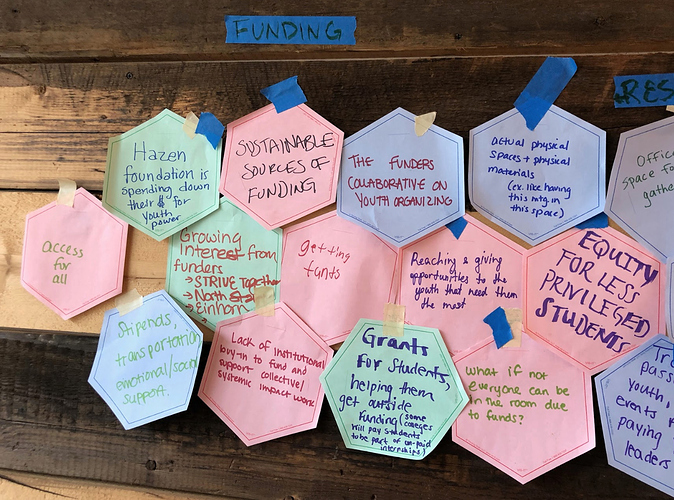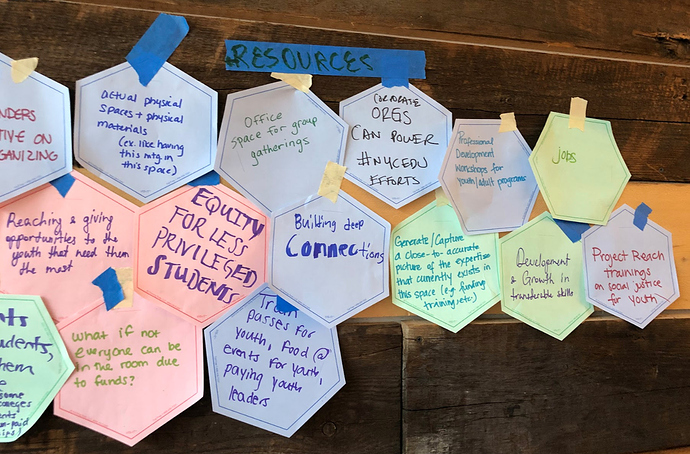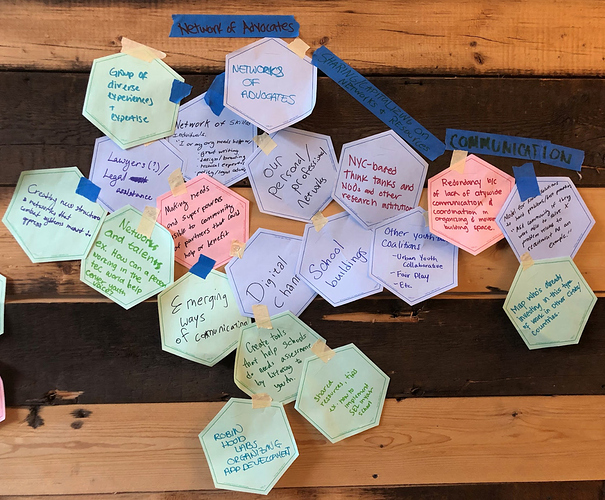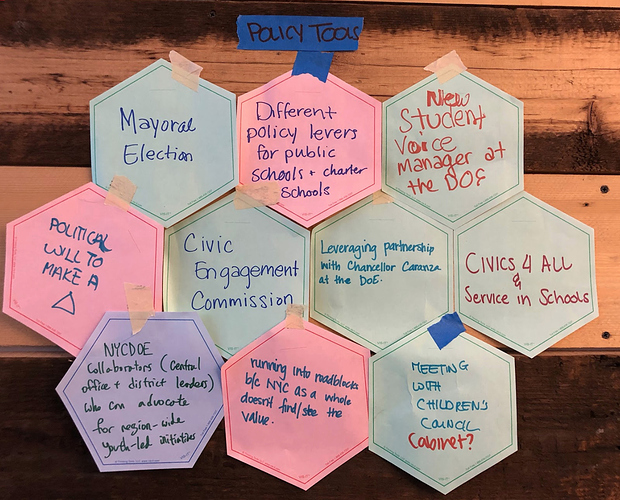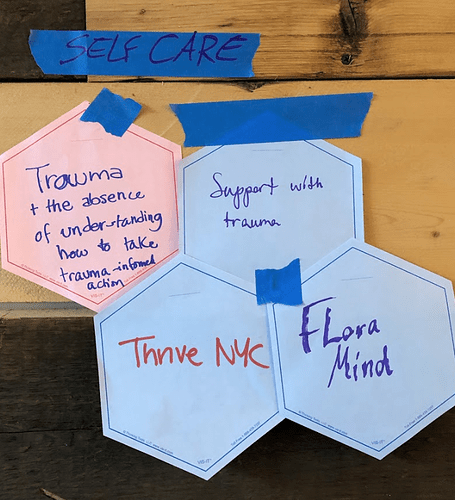On June 8th, representatives of organizations and communities across the city came together to align on values, build relationships, hear youth voices, build a shared understanding of #NYCEDU, set shared goals, and commit to shared actions.
As part of our gathering, we analyzed the challenges to, resources for, and opportunities emerging for youth led collective impact in New York City. We used the constellation mapping method as developed by CoCreative.
We uncovered these themes:
- It is challenging to make youth led collective impact a priority given competing priorities, time constraints, and need for follow-through.
- Not everyone is given awareness and consideration due to discrimination.
- Youth voice faces barriers from adultist mindsets and organizational structures, but we have the opportunity to amplify a growing movement for youth leadership, work inter-generationally, and create new spaces for youth to lead.
- We need sustainable funding and resources, especially to promote equity in access. We do have resources to share with one another, like space, expertise, and knowledge of where funding exists.
- Our networks give us access to skilled and diverse individuals, spaces, and partners. It’s not easy though, to capitalize on our networks, as communication and coordination are real challenges. However, we have the opportunity to create new structures and ways to communicate that combat systems meant to oppress.
- NYC policy is complicated, and the political will to make a change doesn’t always exist. However, the following are high target avenues for influencing policy: the mayoral election, the new student voice manager at the Department of Education, the civic engagement commission, Civics 4 All & Service in Schools, the Children’s Cabinet, and existing NYC Department of Education collaborators.
- There’s potential here to really build momentum and scale.
- This work is hard. We need to practice self care.
As a result of this analysis, several people are collaborating on ways we can shift some of these challenges and take advantage of these resources and opportunities.
For example, support @kliao86 in creating a resource on Messaging the importance of youth voice! Why is it that youth voice and leadership is absolutely essential to this work?
What about you? What are your reactions to this work?
This work is the collaboration of Farzana Pritte, Jamie Lonie, Kyle Liao, Deborah Chang, Brad Whitwell, Caleb Cogan, Dulce Marquez, Leanne Nunes, Nelson Luna, Taylor McGraw, Laura Patterson, AJ De Leon, Kenisha White, Michael Partis, Tyler Rivera, Kadija Koné, Sarah Zapiler, and Rachel Kate Miller. Special thanks to Dulce Marquez, Michael Partis, and Julisa Perez for being members of the organizing team for this event.
To read all the individual challenges, resources, and opportunities that we identified, click here.
- It is challenging to make youth led collective impact a priority given competing priorities, time constraints, and need for follow-through.
Challenges
- Competing Priorities
- Time to collaborate
- <— time!
- Managing expectations about what is actually feasible
- Needing to respond to immediate issues vs build strategic, thoughtful approaches
- commitment + follow through
- Meeting 2019 priorities - what’s the plan b to ensure success?
- Not everyone is given awareness and consideration due to discrimination.
Challenges
- Being as equitable and aware of other people
- VISIBILITY AMONG PARENTS & COMMUNITY MEMBERS
- Discrimination — being taken out of the conversation because of background
Resources
- Engagement — speaking & communicating with others to understand perspectives
- Youth voice faces barriers from adultist mindsets and organizational structures, but we have the opportunity to amplify a growing movement for youth leadership, work inter-generationally, and create new spaces for youth to lead.
Challenges
- Adultism
- MINDSETS "It’s not obvious to me that we need youth-leadership
- Student voice excluded when schools generate goals (CEP goals in NYCDOE)
- Rebranding
Opportunities
- Giving a chance to the Youth to take initiative who are able to have a voice
- Cultural moment (amended in conversation to movement): more youth voices being HEARD
- Media attention on youth-led climate organizing
- Passing on power & working outside of hierarchies
- Create spaces in schools for youth to co-own goals — PD involvement, feedback loops, progress measurement
- Inter-generational collab
- We need sustainable funding and resources, especially to promote equity in access. We do have resources to share with one another, like space, expertise, and knowledge of where funding exists.
Challenges
- SUSTAINABLE SOURCES OF FUNDING
- access for all
- getting funds
- reaching and giving opportunities to the youth that need them the most
- EQUITY FOR LESS PRIVILEGED STUDENTS
- Lack of institutional buy-in to fund and support collective/systemic impact work
- What if not everyone can be in the room due to funds?
Resources
- THE FUNDERS COLLABORATIVE ON YOUTH ORGANIZING
- Stipends, transportation, emotional/social support
- Train passes for youth, food @ events for youth, paying youth leaders
- action physical spaces + physical materials (ex. like having this mtg. in this space)
- Office space for group gatherings
- CORPORATE ORGS CAN POWER #NYCEDU EFFORTS
- Professional Development Workshops for youth/adult programs
- Building deep connections
- Project Reach trainings on social justice for youth
Opportunities
- Hazen foundation is spending down their $ for youth power
- Growing interest from funders → STRIVE Together, North Star, Einhorn
- Grants for students, helping them get outside funding (some colleges will pay students to be part of un-paid internships
- jobs
- Development & Growth in transferrable skills
- Generate/capture a close-to-accurate picture of the expertise that currently exists in this space (e.g. funding training, etc.)
- Our networks give us access to skilled and diverse individuals, spaces, and partners. It’s not easy though, to capitalize on our networks, as communication and coordination are real challenges. However, we have the opportunity to create new structures and ways to communicate that combat systems meant to oppress.
Challenges
- Making needs and superpowers accessible to community of partners that could help or benefit
- Redundancy b/c of lack of citywide communication & coordination in organizing & movement building space.
Resources
- Networks of advocates
- Network of skilled individuals. "I or my org needs help w/ grant writing, design/branding, technical expertise, policy/legal advice
- Lawyers (?)/Legal assistance
- Our personal/professional networks
- NYC-based think tanks and NGOs and other research institutions
- Other youth led coalitions. Urban Youth Collaborative. Fair Play. Etc.
- School buildings
- Digital channels
- Model for know solutions to hard problems/best practices. “Ask community if they were able to solve x problem relating to recruitment as an example.”
Opportunities
- Group of diverse experiences + expertise
- Creating new structures & networks that combat systems meant to oppress
- Networks and talents. ex. How can a person working in the tech world help center youth voice?
- Emerging ways of communication
- Create tools that help schools do needs assessment by listening to youth.
- ROBIN HOOD LABS ORGANIZING APP DEVELOPMENT
- Map who’s already investing in this type of work in other cities/countries.
- NYC policy is complicated, and the political will to make a change doesn’t always exist. However, the following are high target avenues for influencing policy: the mayoral election, the new student voice manager at the Department of Education, the civic engagement commission, Civics 4 All & Service in Schools, the Children’s Cabinet, and existing NYC Department of Education collaborators.
Challenges
- Different policy levers for public schools + charter schools
- POLITICAL WILL TO MAKE A ∆
- running into roadblocks b/c NYC as a whole doesn’t find/see the value
Resources
- NYCDOE Collaborators (central office + district leaders) who can advocate for region-wide youth-led initiatives
Opportunities
- Mayoral election
- New Student Voice Manager at the DOE
- Civic Engagement Commission
- Leveraging partnership with Chancellor Caranza at the DOE
- CIVICS 4 ALL & Service in Schools
- MEETING WITH CHILDREN’S COUNCIL / Cabinet?
- There’s potential here to really build momentum and scale.
Challenges
- Keeping momentum in the movement
Opportunities
- Fun Events 4 students from disadvantaged backgrounds
- Constructive criticism and the space for mutually beneficial collaboration
- a chance to take action ex. rally petition
- SCALE MODEL BEYOND NYC IN FUTURE
- This work is hard. We need to practice self care.
Challenges
- Trauma + the absence of understanding how to take trauma-informed action
Resources
- Support with trauma
- Thrive NYC
- Flora Mind
